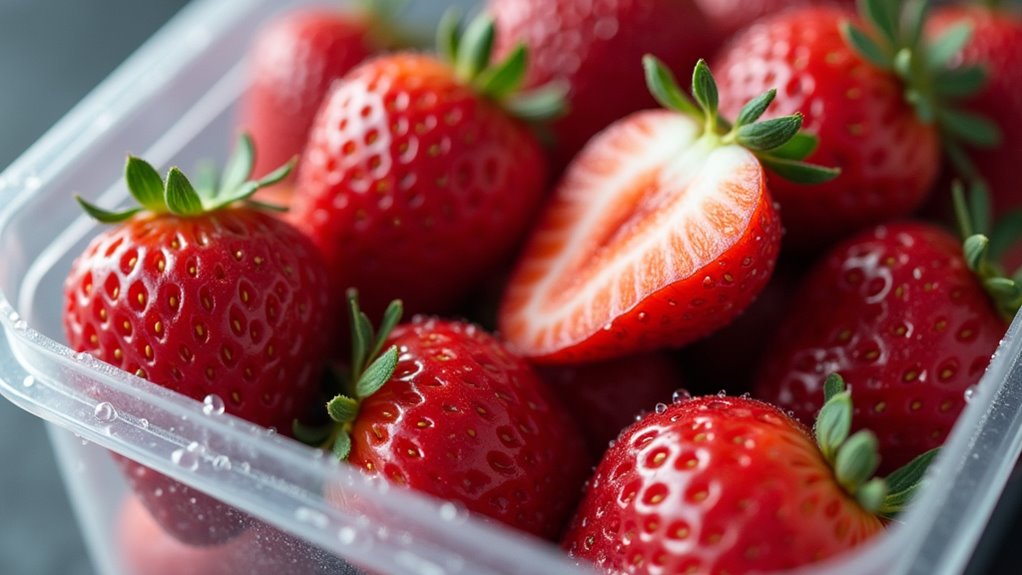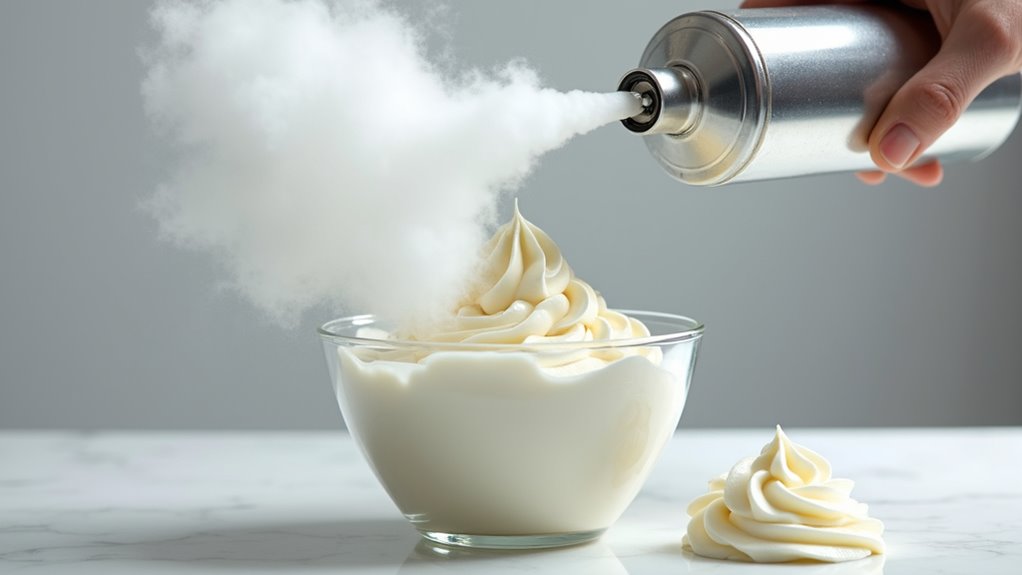Food products need nitrous oxide (N2O) because it’s a multifunctional processing aid that preserves freshness and bolsters quality. You’ll find N2O creates microscopic bubbles that improve texture while preventing oxidation and microbial growth. It’s particularly effective at dissolving in fats and rapidly infusing flavors through cellular disruption at high pressure. This FDA-approved food additive helps manufacturers maintain product consistency and extend shelf life. Understanding N2O’s full capabilities reveals its revolutionary impact on modern food production.
The Science Behind Nitrous Oxide in Food

When examining the science behind nitrous oxide in food applications, it’s vital to understand its unique molecular properties that make it invaluable for food preservation and processing. As a non-polar molecule, N2O readily dissolves in fats and lipids, creating a protective barrier against oxidation and microbial growth modulation. Modern food preservation methods require careful consideration since trace gas levels of N2O can significantly impact food quality. Being odorless and colorless, Nitrous Oxide can enhance food products without altering their taste or aroma profiles.
N2O’s effectiveness doesn’t depend on temperature or pressure, making it highly versatile in food systems. It creates an anaerobic environment by displacing oxygen while maintaining antioxidant preservation through its interaction with reactive oxygen species. The gas’s ability to function with up to 20% oxygen present means you don’t need strict vacuum conditions. When released from pressurized containers, the gas can instantly freeze liquids due to its rapid expansion properties. Its role as an activating gas enables it to inhibit both enzymatic oxidation and microbial proliferation, particularly in lipid-rich foods where it’s most soluble.
Preserving Freshness: How N2O Works

Through its multifaceted preservation mechanisms, nitrous oxide plays a fundamental role in maintaining food freshness by simultaneously targeting multiple spoilage pathways. You’ll find N2O effectively creates an anaerobic environment by displacing oxygen, inhibiting microbial spoilage while preventing oxidative breakdown in your food products.
N2O’s oxygen displacement slows the growth of aerobic bacteria and fungi, protecting against common foodborne pathogens like Salmonella and E. coli. It prevents oxidative rancidity in fats and oils, maintaining original flavors and textures while preserving nutritional content. The gas enables rapid flash freezing techniques that minimize ice crystal formation, ensuring better texture preservation in frozen foods. This approach has proven especially effective for snack food preservation, keeping products like crisps and nuts fresh and crunchy. The addition of sodium hydroxide solutions during food preservation processes helps maintain optimal pH levels for preventing unwanted biological activity. Food grade N2O is widely recognized as a safe additive by regulatory authorities worldwide.
This systematic approach to preservation extends shelf life while retaining paramount organoleptic properties, making N2O an indispensable tool in modern food preservation technology.
Texture Enhancement and Flavor Impact

When you apply nitrous oxide in food production, you’ll find it creates microscopic bubbles that effectively aerate ingredients, resulting in profoundly lighter and more delicate textures in products like whipped cream and mousses.
The rapid dissolution of N2O into fats and liquids generates stable, uniform structures that maintain their consistency throughout storage and serving. You’ll notice that this aeration process simultaneously accelerates flavor infusion, as the gas helps distribute taste compounds more evenly throughout the product while protecting volatile aromatics from degradation. The gas also delivers extended shelf life to culinary creations by preventing oxidation. Adding a touch of vanilla extract creates rich, complex flavors that enhance the overall taste profile. The gas is particularly effective in preventing fruit decay by inhibiting ethylene production and slowing the ripening process.
Aeration Creates Lighter Textures
Nitrous oxide’s remarkable ability to create lighter textures revolutionizes food production through controlled aeration. You’ll find that N2O’s efficient incorporation of air bubbles maintains volume consistency while enhancing the sensory perception of aeration in different food applications. The controlled release of gas guarantees uniform distribution, resulting in perfectly textured products every time. The scientific process creates microbubble structures between 10 and 50 microns in size for optimal texture enhancement.
N2O rapidly aerates batters and creams, reducing production time while achieving ideal fluffiness in high-volume kitchen settings. The gas prevents ice crystal formation in frozen desserts, creating smoother textures and improved mouthfeel across batches. As a food grade gas, nitrous oxide meets strict purity standards essential for culinary applications. In molecular gastronomy, chefs utilize innovative culinary techniques to create visually stunning dishes. Controlled dispensing through specialized valves enables precise aeration levels, eliminating variations in texture that often occur with manual whipping methods.
This systematic approach transforms traditional food preparation, ensuring consistent quality and efficiency in professional kitchens.
Rapid Flavor Infusion Process
Beyond its aeration capabilities, the rapid flavor infusion process powered by N₂O represents a groundbreaking advancement in culinary science. When you use this method, high-pressure nitrous oxide forces liquid into porous ingredients while simultaneously creating gas bubbles that disrupt cellular structures. Traditional infusion methods can require hours to weeks to achieve similar results.
This rapid cellular disruption optimizes volatile compound extraction through multiple mechanisms. You’ll achieve in minutes what traditionally takes hours or days through conventional steeping. The method extracts more bright flavors while minimizing bitter notes. The process works best at room temperature, where N₂O creates vigorous bubbling that ruptures cell membranes and improves porosity. Using a whipped cream dispenser creates approximately five times atmospheric pressure for optimal infusion.
During depressurization, the escaping gas pulls flavors from the ingredients into your liquid carrier. This pressure-driven extraction method preserves heat-sensitive compounds while delivering intense flavor profiles through efficient bidirectional transfer between solids and liquids.
Modern Culinary Applications
While traditional culinary applications primarily focused on whipped cream, modern gastronomy has revolutionized N2O’s role in professional kitchens. Through molecular food engineering and advanced emulsion stabilization techniques, you’ll find N2O transforming textures and revolutionizing food preparation across diverse culinary applications.
You can create stable foams for both savory and sweet dishes, achieving light, airy textures that improve your dish’s visual appeal and mouthfeel.
When you’re working with frozen desserts, N2O helps prevent large ice crystal formation, resulting in smoother ice cream and finer sorbet textures.
You’ll achieve rapid flavor infusions by using N2O to dissolve flavor compounds into liquids and gels, while maintaining precise control over texture and stability.
These innovations have made N2O an indispensable tool in contemporary cuisine, enabling chefs to push creative boundaries while maintaining technical precision.
Safety Standards and Best Practices
When working with nitrous oxide in food preparation, you’ll need to follow strict storage protocols that include maintaining proper temperature control and using pressure-rated containers certified for food-grade N2O.
Your equipment must meet specific safety certifications, including compatibility with food-grade regulators and proper ventilation systems to prevent oxygen displacement. You’ll need documented training in proper handling procedures, hazard communication, and regulatory compliance measures to guarantee both worker safety and adherence to FDA GRAS standards.
Storage and Handling Protocols
The safe storage and handling of nitrous oxide requires strict adherence to established protocols that protect both personnel and product integrity. You’ll need to maintain strict humidity control in well-ventilated spaces while implementing regular leak detection procedures to guarantee safety compliance.
Your storage area must protect cylinders from direct sunlight and maintain consistent temperature conditions to prevent pressure fluctuations.
- Store cylinders upright and securely anchored in dry, temperature-controlled environments away from incompatible materials and flammables
- Conduct routine inspections of valves, fittings, and containers for signs of corrosion, damage, or potential leaks
- Maintain proper documentation of storage conditions, handling procedures, and safety checks while ensuring all containers meet food-grade certification standards (EU E942)
Your facility must always keep escape routes clear and monitoring systems operational for immediate response to potential emergencies.
Equipment Safety Certification Requirements
Every piece of equipment used for nitrous oxide in food production must meet rigorous safety certification requirements to guarantee consumer protection and regulatory compliance. You’ll need to ascertain your equipment meets FDA standards, including GRAS recognition and proper food-grade labeling to distinguish it from medical variants. Regulatory oversight demands that you purchase supplies exclusively from certified distributors who maintain strict purity standards.
Your equipment must adhere to specific compliance benchmarks, including third-party audits that verify safety standards and purity levels. You’re required to use components made from food-safe materials, particularly stainless steel, and maintain dedicated systems to prevent cross-contamination. Remember, your pressure regulators must be specifically designed for culinary applications, and you’ll need to keep detailed maintenance logs to demonstrate ongoing protocol adherence.
Training and Compliance Measures
Maintaining compliant operations with nitrous oxide requires exhaustive staff training programs alongside rigorous safety protocols. You’ll need to implement meticulous supplier onboarding processes and maintain strict regulatory oversight to guarantee food-grade N₂O meets quality standards. Your staff must understand proper handling procedures, emergency protocols, and the critical distinctions between food-grade and medical-grade products.
Conduct regular training sessions on equipment maintenance, ventilation requirements, and proper storage techniques to prevent contamination and secure workplace safety.
Document all safety procedures, including emergency response plans and primary aid protocols, keeping detailed records of staff certifications and training completion.
Establish clear communication channels with certified suppliers, regularly verify their credentials, and maintain updated safety data sheets for all N₂O equipment and storage containers.
Environmental Benefits of N2O Usage
Understanding nitrous oxide’s environmental impact reveals surprising benefits when properly managed in food production systems. You’ll find that controlled N2O usage in food processing contributes to climate change mitigation by reducing comprehensive emissions compared to alternative methods.
When integrated into sustainable agricultural practices, it supports precision application that minimizes nitrogen waste and runoff.
Proper N2O management in food production aligns with ozone layer protection goals by preventing excess releases into the atmosphere. You’re actually helping preserve stratospheric ozone when you choose food products that use optimized N2O systems, as they typically emit less than conventional processing methods.
This controlled approach also supports water quality by reducing nitrogen pollution in waterways and protects biodiversity through balanced nitrogen cycles in agricultural ecosystems.
Storage and Handling Requirements
Safe storage of nitrous oxide demands precise protocols and specialized handling procedures. You’ll need to establish a cylinder turnover schedule and maintain proper ventilation requirements to guarantee safety. Your storage area must be temperature-controlled, well-ventilated, and protected from weather exposure while keeping cylinders secure and upright.
Monitor pressure levels between 1-6 atmospheres absolute, using calibrated gauges to detect abnormal conditions. Install appropriate brackets and straps to prevent cylinders from tipping, while making certain they’re stored away from flammable materials. Maintain detailed documentation of inspections, implement access restrictions for trained personnel only, and follow local regulatory requirements for hazmat storage.
Remember to check cylinders regularly for leaks, dents, or expiration dates, and always use approved valve systems that are free from contamination. Proper storage assures both safety and product quality.
Impact on Food Manufacturing
The strategic integration of nitrous oxide in food manufacturing revolutionizes product development across multiple dimensions. You’ll find it enhances production efficiency while maintaining product quality through precise gas injection systems and automated controls. The technology enables sustainable manufacturing practices by reducing waste and optimizing batch processes.
N₂O’s versatility drives innovation across multiple product categories, from frozen desserts to molecular gastronomy applications. It’s particularly effective in streamlining production timelines through rapid aeration and freezing cycles, leading to significant cost savings. You’ll notice how it supports clean-label compliance, which has become essential for consumer adoption of processed foods.
The gas’s ability to preserve nutrients, maintain texture, and extend shelf life makes it an indispensable tool in modern food production, facilitating both scalability and consistency in manufacturing operations.
Future Trends in N2O Food Technology
Modern food scientists predict a transformative evolution in N₂O food technology over the next decade. As shifting consumer preferences drive innovation, you’ll see significant changes in how nitrous oxide shapes the food industry.
Sustainable production methods are becoming indispensable as manufacturers respond to environmental concerns and regulatory pressures.
The Asia-Pacific region leads growth at 8.05% CAGR, with expanding applications in creative food formulations and texture modification. Advanced preservation techniques combine N₂O with modified atmosphere packaging (MAP), extending shelf life while reducing food waste. Eco-conscious alternatives emerge through improved catalytic processes, as companies balance innovation with environmental standards.
This technological progression promises augmented culinary experiences while addressing sustainability challenges, positioning N₂O as an essential component in future food manufacturing processes.
Frequently Asked Questions
Can Nitrous Oxide Affect the Nutritional Value of Preserved Foods?
When properly used, nitrous oxide actually helps maintain the nutritional value of your preserved foods through augmented nutrient retention. It creates an oxygen-free environment that protects vitamins, particularly C and B complexes, from oxidative degradation.
You’ll find that N2O’s preservation efficiency extends to protecting unsaturated fats and amino acids while preventing microbial activity that could otherwise break down nutrients. It’s particularly effective at maintaining the original nutritional profile during long-term storage.
Does N2o-Preserved Food Taste Different From Traditionally Preserved Products?
You won’t notice significant taste differences in N2O-preserved foods compared to traditionally preserved products in most applications. While N2O is non-reactive and maintains original flavor profiles, specific applications can produce subtle variations.
In beverages, you might detect a slight sweetness, and some products may show amplified flavor profile characteristics due to N2O’s solubility. However, when used purely for preservation, N2O doesn’t create altered texture characteristics or taste modifications in your food.
How Long Can Food Products Remain Fresh With N2O Treatment?
You’ll find that N2O treatment considerably extends shelf life, typically doubling or tripling product freshness compared to untreated items. Through effective oxidation prevention, your dairy products can last 2-3 weeks longer, while whipped creams maintain their texture for up to 14 days.
The exact duration depends on your storage conditions, packaging integrity, and initial product quality. You’ll get ideal results when you maintain consistent temperatures and proper gas purity levels.
Are There Alternatives to Nitrous Oxide for Food Preservation?
Yes, you’ll find several effective alternative preservation methods to nitrous oxide. You can use modified atmosphere processing with nitrogen or carbon dioxide to inhibit microbial growth.
Plant-based options like celery powder, Swiss chard, and spinach juice provide natural nitrites for preservation. You can also employ microbial inhibition techniques through yeast preservatives and fermented ingredients. These alternatives align with clean-label demands while maintaining food safety and quality standards.
What Foods Should Not Be Treated With Nitrous Oxide?
You should avoid using nitrous oxide treatment for raw meats, unpasteurized dairy products, and fresh produce due to the presence of bacteria that requires more reliable preservation methods.
Foods with high moisture content or those prone to rapid spoilage shouldn’t rely solely on nitrous oxide due to lack of regulation in its antimicrobial effectiveness.
Furthermore, you’ll want to exclude acidic foods and those requiring long-term preservation from nitrous oxide treatment.

